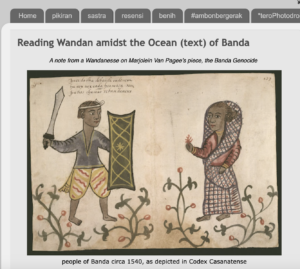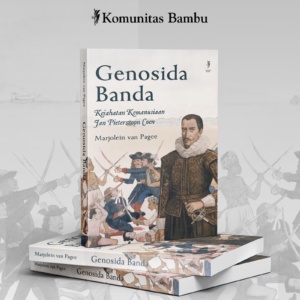Reading Wandan in the middle of the Banda Sea
A note from a Wandanese on Marjolein Van Pagee’s piece, ‘Genosida Banda’
Terometamorfolio, March 19, 2024, By: Muhammad Burhanudin Borut
 Let me introduce myself, I’m from Banda, Moluccas.
Let me introduce myself, I’m from Banda, Moluccas.
– Oh, Banda Neira, the spice islands?
Yes and no…
– What do you mean?
My village’s name is Banda Eli, on the Kei Islands.
– So, not Banda Neira?
(Originally we are from) Banda, but we are in Kei.
– What do you mean?
Every time a Wandanese goes somewhere and introduces him or herself as being originally from the Banda Islands, the conversation goes something like this. Questions, raised eyebrows even, are the common response when people hear the word “Wandan”, this is in stark contrast with when the word “Banda” is used. The reason is simple, the general public is not familiar with the word “Wandan”. Most people don’t know the reason why we call ourselves Wandanese, or “orang Banda asli” (original Bandanese). They don’t know that the islands that they are familiar with are remembered as Wandan in our hearts.
Therefore, introducing yourself as a Wandanese is never an easy task. The war on nutmeg in early 17th century erased Wandan and the Wandanese from the mainstream history books about Banda. The VOC’s barbaric action had systematically robbed the Wandanese of their spatial identity as the original inhabitants of Banda. Thousands of Wandanese were killed, exiled, robbed from their living space, displaced and ended up scattered across the archipelago. The genocide committed by the VOC created an empty space of Banda, a limbo from which the Wandanese and their narrative vanished into the insignificance. As a result, every time an introductory session touches upon the topic of one’s origin, a Wandanese has to explain himself/herself at greater length than one should normally do.

Wandanese must have a lot of knowledge on the tangled web of history, geopolitics, and colonial greed to explain why our ancestors were expelled from Banda. Every time someone asks how our ancestors migrated to the Kei Islands, we are struggling with explaining ourselves because of the collective memory that is ruined.
The long, episodic migration under constant threats of VOC has made the Wandanese memory, history and identity fragmented. Our stories are linked to the stories of people in Gorom, Geser, Kur, Tayando, all small islands on the ridge of Banda arch. Retracing ourselves through this complex web of memories is often too emotional to bear.
That’s why I am often reluctant to introduce myself as a Wandanese. In the past, I didn’t argue when friends or colleagues introduced me in very general terms as a Moluccan, a Keiese or a Bandanese. I rarely objected. This, after all, is not completely wrong although it’s not completely right either.
Today, I promise myself to speak loudly about my identity and origin. I will no longer hesitate to speak about Wandan. From now on, I shall introduce myself as a Wandanese. Marjolein’s book, Genosida Banda (the Banda Genocide), has reshaped my awareness. She brought me back to the shore of Banda Neira where I rediscovered Wandan in the ocean texts of Banda.
Declaring oneself as a Wandanese is certainly not a matter of semantic. Introducing Wandan in the conversation means a recognition of the original inhabitants of the Banda Islands, who embarked on a “hijrah” to various places throughout the archipelago, most importantly to the Kei islands. Speaking of Wandan is speaking of resilience, demonstrating that we remain intact, undefeated, unbroken. This is, indeed, an act of resistance.
* * *
The recognition of Wandan and the Wandanese narrative is one of the key themes of Marjolein’s book Genosida Banda. In the introduction of the Indonesian edition, published by Komunitas Bambu, Marjolein argues that the erasure of Wandan, both in historical and contemporary publications, resulted in a flawed history. According to Marjolein, the history is now seen through a colonial lens only, as the perspective of the direct victims on the nutmeg islands are excluded.
In her book, Marjolein, launches a strong critique on European biased and colonial writing regarding Banda. “Colonial sources contain lies” she writes. Hence, “there will be no breakthrough if we allow these lies to continue”.
 However confrontational it may sound, Marjolein’s call does not mean to completely disregard colonial sources. Rather, it serves as an invitation to criticize colonial texts, understanding its subjective nature, and questioning as hard as one could the motivation behind the colonial narratives. Marjolein asks her readers to fully deconstruct the historical perspective that was created based on the subjective European view of what they called ‘the East’. She, without hesitation, explains how racial prejudice and narrow-minded theological perspectives fostered hatred that led to atrocities directed at anyone considered not (fully) European or whose presence was in opposition with Europe.
However confrontational it may sound, Marjolein’s call does not mean to completely disregard colonial sources. Rather, it serves as an invitation to criticize colonial texts, understanding its subjective nature, and questioning as hard as one could the motivation behind the colonial narratives. Marjolein asks her readers to fully deconstruct the historical perspective that was created based on the subjective European view of what they called ‘the East’. She, without hesitation, explains how racial prejudice and narrow-minded theological perspectives fostered hatred that led to atrocities directed at anyone considered not (fully) European or whose presence was in opposition with Europe.
To demonstrate this, Marjolein reveals how Jan Pieterszoon Coen, the notorious Governor General of the VOC, played the racial card in the way he labeled the Wandanese. She shows how Coen’s view of the Wandanese as ‘deceitful uncivilized Moors’ served as the pretext to justify his order that aimed to kill all the Wandanese. Marjoleine explains how some of these prejudices still linger on in contemporary colonial-based historical accounts.
“In the Dutch archives, the Bandanese are referred to as Moors, the infidel, the unfaithful who cannot be trusted or expected of goodness. The Bandanese are accused of cheating by tampering the scales and offering mouldy nutmeg. […]
In principle they (ed.VOC) just don’t want to pay more than their competitors. […]
…However, during the first visit in 1599, it soon became clear that the Bandanese were experienced traders and had a unique trading position.”
Aside from exposing various European prejudices in mainstream historical literature on Banda, Marjolein also contributes to a more inclusive historical discourse. Her book Genosida Banda not only presents history as a series of chronological dates and events, but also as a human story about a group of people, no matter how fragmented their own collective memory is. As part of mainstream history, which predominantly revolves around ‘his’ rather than ‘her’ story, Marjolein’s book redirects the focus towards the Wandanese. In doing so, she has helped us to launch our own narrative, which encourages us to (re)write our collective story, the story of Wandan.
Certainly, Marjolein is not the first foreign writer that acknowledges the existence of the Wandanese. Timo Kaartinen, a Finnish professor of anthropology, has also written extensively about how Wandanese maintained their culture and collective memory of Banda through songs and poetry (onotani) for hundreds of years in the periphery of Kei.
The presence of the Wandan people on Kei can even be traced back to the mid-17th century. In 1646, for example, an expedition led by Adrian Dortsman’s had recorded the settlement of the Wandan diaspora in the negeri of Eli, Elat and at the edge of the negeri Haar. Two centuries later, Van Hoevell (1890) and Alfred Russel Wallace also mentioned about the presence of the Wandanese on Kei. In his travelogue, Malay Archipelago (1869), Wallace even describes the differences in characteristics, culture and religion between the Wandanese and the native Keiese.
Even though she is not a pioneer, Marjolein’s writing is, somehow, more transformative. It has the power to catalyze change among the Wandanese. The main difference between Marjolein and other writers is that Marjolein composed her script with a complete critical awareness. She firmly believes that the Wandanese should dominate the historical discourse on Banda, hence she goes much further than only acknowledging the existence of the Wandanese.
Marjolein’s determination to create a large space for the victim’s narrative certainly needs to be welcomed by all Wandanese. Her courage to dismantle mainstream narratives that are insensitive to people’s story needs to be utilized as a momentum to reconstruct our collective memory. It is time for the Wandanese, as well as other ethnic groups in the Moluccas and the Indonesian archipelago, to talk more openly about our history and identity. We must stop treating the collective memory of our own as merely a myth, imagination of an over proud tribe, or the tragedy of the defeated. We need to welcome our oral traditions as a historical source from which examination and analysis can be conducted.
Wandanese and other communities across the archipelago may borrow the concept of meta-history to incorporate their collective memory into the mainstream discourse. In the study of anthropology, the meta-historical concept has been used as a tool to understand the context and to reconcile the gap between a community’s recollection of events and historical documents. Timo Kaartinen, in his study about the Wandanese, had successfully employed this notion. He managed to develop a more coherent narrative of the Wandanese migration and resilience in Kei by consistently examining the Wandanese collective memories and the colonial documents.
Marjolein’s book Genosida Banda has given new hope to redirect the discourse on Banda. It has provided a momentum to produce a more critical and inclusive narrative of this archipelago history, one which does not overlook the Wandanese identity and their narrative.
But, first, one should certainly dare to embrace his own story.
So, to restart, let me reintroduce myself.
My name is Burhanudin Borut.
My ancestors came from the group of islands you’ve known as Banda,
the origins of nutmeg, the mystica fragrans.
We call that cluster of land and water as ‘Wandan’.
No, I’m not just from Banda,
I am a Wandanese,
I am Wandansio!
—
Read also:
